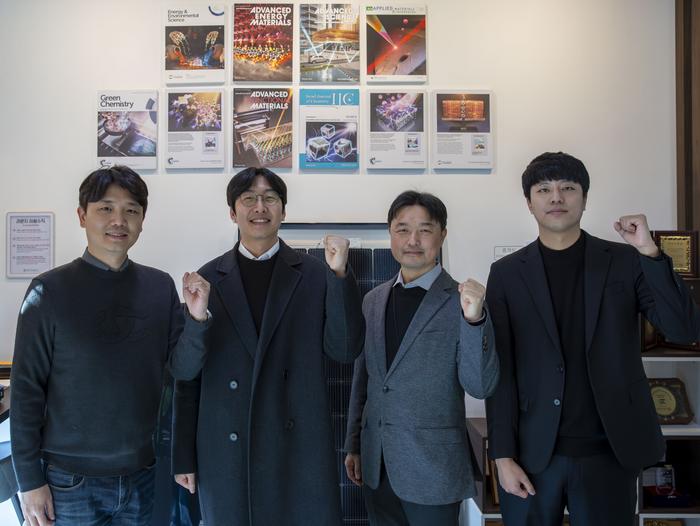The quest for efficient solar energy solutions has taken a significant leap forward with the recent groundbreaking advancement by the Korea Institute of Energy Research (KIER). The research team at KIER, led by Dr. Inyoung Jeong, has introduced a new generation of ultra-lightweight flexible perovskite/CIGS tandem solar cells, achieving an unprecedented power conversion efficiency of 23.64%. This figure stands as the highest efficiency ever recorded for flexible perovskite/CIGS tandem solar cells, positioning them at the forefront of renewable energy technologies.
Perovskite solar cells represent a revolutionary approach in the realm of photovoltaic technology. They exhibit remarkable light-absorbing capabilities, which make them a solid contender to overcome the limitations of conventional crystalline silicon solar cells. While silicon-based cells dominate the market due to their affordability and widespread manufacturing capabilities, they have begun to plateau in efficiency as they reach their theoretical limits. In contrast, tandem solar cells that pair silicon with perovskite materials have emerged as promising alternatives, significantly enhancing overall energy conversion rates.
The unique composition of tandem solar cells allows for greater versatility in application, particularly in sectors where the adaptability and lightweight properties of solar panels are essential. Traditional perovskite/silicon cells, despite achieving efficiency rates as high as 34.6%, face challenges concerning weight and damage susceptibility. These problems hinder their application in contexts such as aerospace and automotive industries, where weight considerations and structural integrity are critical.
In an effort to address these challenges, the innovative work by the KIER research team has led to the development of flexible thin-film perovskite/CIGS tandem solar cells. CIGS, known for being lightweight and flexible, is particularly suitable for integration into curved surfaces represented in modern architecture, vehicles, and other innovative applications. However, previous iterations suffered from lower efficiency rates and complex manufacturing processes, creating barriers to market readiness.
The KIER team’s novel approach involved a simple lift-off process. This methodology entails coating a polyimide layer onto a glass substrate before fabricating the perovskite/CIGS tandem solar cell atop the polyimide. The lift-off process allows for stable and uniform layer deposition which leads to significantly higher reproducibility and efficiency compared to traditional methods. The rigid glass substrate utilized in this process enhances the stability during fabrication and ultimately contributes to the performance improvement of the solar cells.
Moreover, the team identified a critical improvement mechanism during the fabrication process that involves managing the diffusion of alkali metals from the glass substrate into the CIGS layer. Excessive diffusion of potassium, in particular, can introduce defects in the absorber layer, negatively impacting the overall efficiency of the solar cells. To combat this issue, the researchers leveraged computational science to predict that the polyimide layer could effectively suppress potassium diffusion, resulting in fewer defects and a marked increase in performance.
Not only did the innovative fabrication process contribute to efficiency gains, but it also provided the new cells with outstanding durability. The research team undertook rigorous mechanical testing, performing 100,000 bending cycles to evaluate the resilience of the solar cells. Impressively, the cells maintained an efficiency of 97.7% post-testing, showcasing their robustness and suitability for challenging real-world applications.
Dr. Inyoung Jeong emphasized the significance of this achievement, noting that it lays the groundwork for future advancements toward a goal of achieving 30% efficiency in ultralight flexible solar cells. The implications of this work are vast, with the potential to expand applications in renewable energy, particularly in highly portable and adaptable modules.
Dr. Kihwan Kim, another prominent figure in the research, highlighted the power-to-weight ratio associated with the new solar cells, stating it is approximately ten times greater than traditional perovskite/silicon tandem solar cells. This breakthrough promises to enable innovative applications in demanding environments, such as in building exteriors and on vehicles, where every gram counts, and efficiency is paramount.
The research results were published in the prestigious journal Joule, which underscores the high impact of this discovery on the field of energy and materials science. This accomplishment was made possible through a collaborative effort involving distinguished scholars like Professor Tae Kyung Lee of Gyeongsang National University and Professor Hae-Jin Kim of Yonsei University, showcasing the strength of collaborative research in driving technological advancements.
As renewable energy solutions continue to shape a sustainable future, the ultra-lightweight flexible perovskite/CIGS tandem solar cells developed by KIER serve as a formidable step toward overcoming existing barriers in solar cell technology. Their impressive efficiency, durability, and lightweight nature present an exciting prospect for the future of energy generation, particularly as industries strive for greener alternatives in a world increasingly reliant on sustainable solutions.
With ongoing efforts to refine manufacturing processes and enhance the stability of these solar cells, the KIER research team aims to fortify the competitiveness of the renewable energy sector. This breakthrough not only contributes to advancing solar technology but also signals the potential for widespread adoption of renewable energy solutions across various industries, ensuring a sustainable energy future.
The study not only sheds light on the technical advancements in solar technology but also holds promise for spurring innovations that can lead to more efficient, adaptable, and sustainable energy practices globally. As researchers continue to explore the possibilities of combining cutting-edge materials and technologies, the future of solar energy looks bright, offering endless opportunities for innovation in the pursuit of clean energy.
Subject of Research: Development of ultra-lightweight flexible perovskite/CIGS tandem solar cells
Article Title: Flexible and lightweight perovskite/Cu(In,Ga)Se2 tandem solar cells
News Publication Date: 19-Mar-2025
Web References: DOI link
References: Joule Journal, March 2025
Image Credits: KOREA INSTITUTE OF ENERGY RESEARCH(KIER)
Keywords
solar energy, perovskite cells, CIGS, renewable energy, efficiency, lightweight technology, advanced materials, energy research, photovoltaic technology.




